Beginnen mit Maschinenstickerei für Anfänger kann eine aufregende Reise sein, Aber es ist ganz natürlich, dass man unsicher ist, wo man anfangen soll. Welche Werkzeuge benötigen Sie?? Wie funktioniert der Prozess?? Machen Sie sich keine Sorgen – wir sind für Sie da!
Dieser Artikel soll Sie Schritt für Schritt anleiten, So wird das Sticken einfach und angenehm. Egal, ob Sie Ihrer Kleidung eine persönliche Note verleihen oder einzigartige Geschenke kreieren, Das Erlernen der Grundlagen kann endlose kreative Möglichkeiten eröffnen.
Von der Einrichtung Ihrer Maschine bis zur Auswahl der richtigen Materialien, Wir erklären Ihnen alles, was Sie wissen müssen. Lassen Sie uns gemeinsam die wunderbare Welt der Maschinenstickerei erkunden!
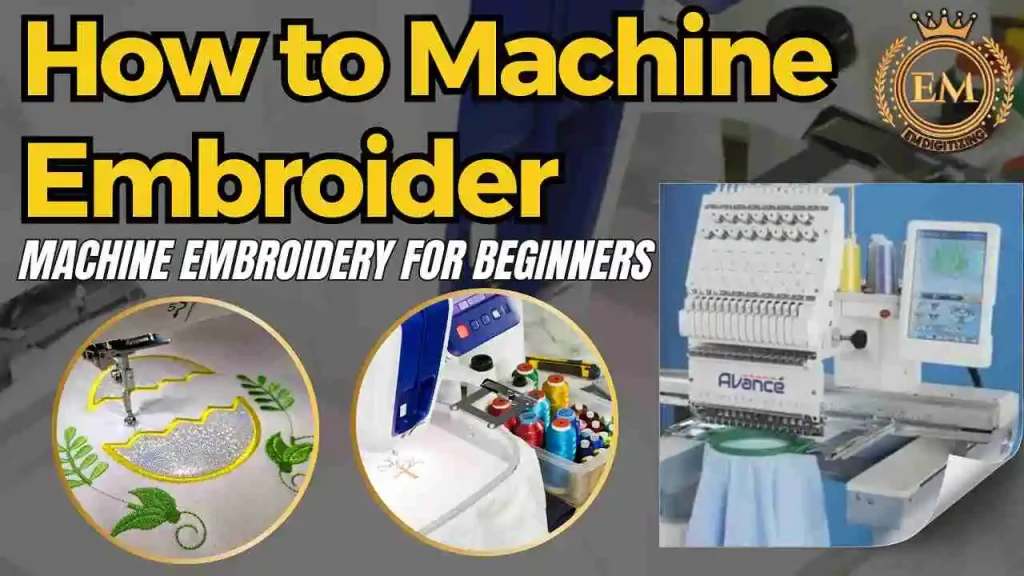
Wie man maschinell stickt | Maschinenstickerei für Anfänger
Was ist Maschinenstickerei??
Dabei handelt es sich um eine moderne Methode, mit modernen Nähmaschinen Designs auf Stoffen hinzuzufügen. Im Gegensatz zur traditionellen Handstickerei, Dieser Prozess ist automatisiert, ermöglicht schnelles und präzises Nähen. Durch Hochladen einer digitalen Designdatei, Die Maschine entfaltet ihre Magie, um das Muster auf Ihrem Stoff zum Leben zu erwecken.
Mit der Möglichkeit, mehrere Garnfarben zu verwenden und komplizierte Details zu erstellen, Maschinenstickerei ist eine gute Option, um professionell aussehende Designs auf Kleidung zu erstellen, Zubehör, und Heimdekoration. Es ist eine Mischung aus Kreativität und Technologie, Perfekt für alle, die effiziente und qualitativ hochwertige Ergebnisse suchen.
Vorteile und Grenzen der Maschinenstickerei
Es ist eine effiziente Möglichkeit, das Sticken zu erlernen und schöne Dinge zu schaffen Designs auf Stoff. Wenn Sie die Vorteile und Grenzen kennen, können Sie die besten Ergebnisse erzielen.
Vorteile
- Geschwindigkeit und Effizienz: Maschinenstickereien fertigen Designs viel schneller als Handstickereien, Damit eignet es sich perfekt für große Projekte.
- Präzision und Genauigkeit: Sorgt für einwandfreie Nähte, Erstellen Sie mühelos komplizierte und detaillierte Muster.
- Gleichmäßigkeit: Erzeugt gleichbleibende Qualität über mehrere Artikel hinweg, Daher ist es ideal für Großbestellungen.
- Vielseitigkeit: Funktioniert auf einer Vielzahl von Stoffen, von robustem Denim bis hin zu zarter Seide, bietet endlose Möglichkeiten.
- Kosteneffizienz: Reduziert die Arbeitskosten und steigert die Produktivität bei Großprojekten.
- Haltbarkeit: Fadenbasierte Stickereien sind im Vergleich zu anderen Druckverfahren langlebig.
- Komplexe Designfähigkeit: Bewältigt anspruchsvolle Muster, die manuell nur schwer zu erreichen sind.
Einschränkungen
- Hohe Anfangsinvestition: Stickmaschinen und Software können teuer sein, besonders für Anfänger.
- Lernkurve: Für einen effektiven Betrieb sind technische Kenntnisse und Übung erforderlich.
- Begrenzter künstlerischer Ausdruck: Es fehlt die persönliche Note und die einzigartigen Variationen der Handstickerei.
- Wartungsbedarf: Regelmäßige Wartung und Instandhaltung sind notwendig, um Maschinen in einem Top-Zustand zu halten.
- Abhängigkeit von der Technologie: Maschinen- oder Softwarestörungen können die Produktion erheblich verzögern.
- Komplexes Setup: Das Vorbereiten der Maschine zum Sticken erfordert zeitaufwändige Schritte wie das Einfädeln und Einrichten des Stoffes.
Wichtige Werkzeuge und Materialien, die für die Maschinenstickerei benötigt werden
Maschinenstickerei für Anfänger kann spannend und lohnend sein, Aber die richtigen Werkzeuge sind entscheidend, um großartige Ergebnisse zu erzielen. Von der Auswahl der perfektes Stickdesign auf die Verwendung der richtigen Materialien, Jeder Schritt spielt eine entscheidende Rolle auf Ihrer Stickreise.
- Stickmaschine
- Stickgarne
- Stabilisatoren
- Nadeln (Sticknadeln)
- Stickrahmen
- Stoff (Baumwolle, Leinen, usw.)
- Schere (Klein, Scharfe)
- Markierungswerkzeuge (Abwaschbare Stifte oder Kreide)
- Vorgefertigte Stickdesigns oder individuelle Designs
1. Stickmaschine

Eine Stickmaschine ist das Kernwerkzeug für jedes Stickprojekt. Für Anfänger, Es ist wichtig, das zu wählen beste Stickmaschine für Anfänger das ist benutzerfreundlich, verfügt über automatische Funktionen, und bietet integrierte Designs zum Üben. Maschinen wie der Brother PE535 oder Baby Lock Aventura 2 sind großartige Optionen, da sie vorinstallierte Designs und benutzerfreundliche Steuerelemente bieten. Beginnen Sie mit einem einfachen Stickmaschine für Anfänger hilft Ihnen, sich auf das Lernen zu konzentrieren, ohne überfordert zu werden.
2. Stickgarne
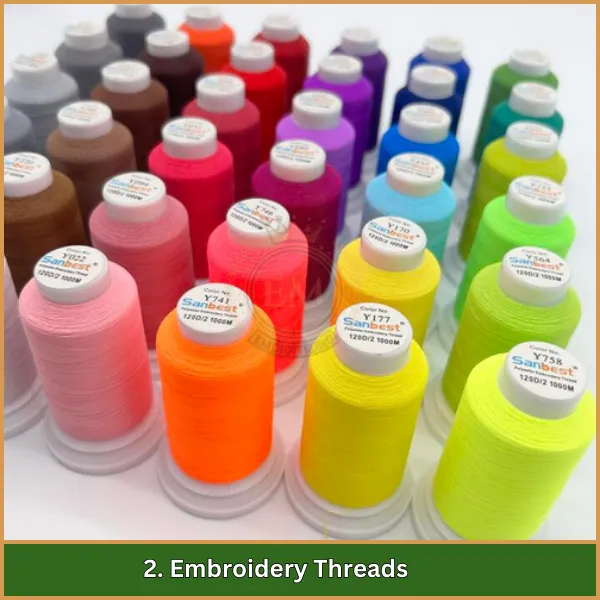
Fäden erwecken Ihre Designs zum Leben! Anfänger sollten Polyester-Stickgarne verwenden, da diese langlebig und weniger bruchanfällig sind. Sie finden diese Fäden in leuchtenden Farben und können sie in Kunsthandwerksgeschäften kaufen, Online-Plattformen wie Amazon, oder spezielle Stickereigeschäfte. Passen Sie den Gewindetyp immer an Ihr Projekt an, um die besten Ergebnisse zu erzielen.
3. Stabilisatoren
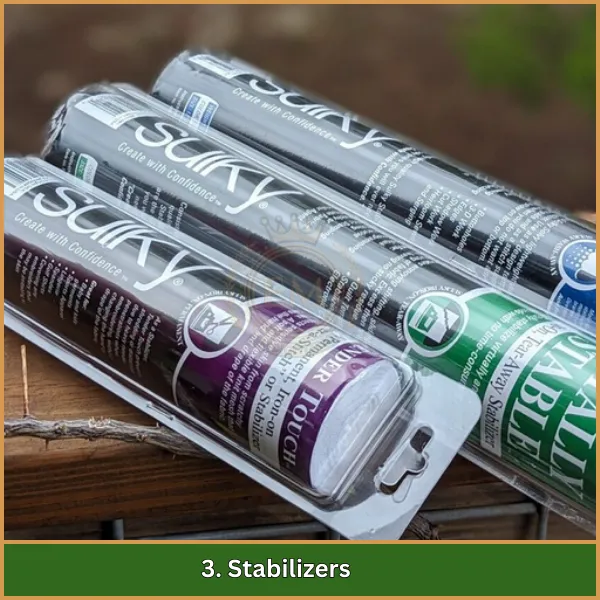
Stabilisatoren verhindern, dass sich der Stoff beim Nähen verschiebt oder kräuselt. Für Anfänger, Abreißstabilisatoren sind einfach zu verwenden und für die meisten Projekte geeignet. Ausgeschnittene Stabilisatoren eignen sich besser für dehnbare oder empfindliche Stoffe, Auswaschbare Stabilisatoren eignen sich hervorragend für Projekte, die ein sauberes Finish erfordern. Stabilisatoren gibt es in Stoffgeschäften oder online, und es ist hilfreich, eine Sorte zum Experimentieren vorrätig zu haben.
4. Nadeln (Sticknadeln)

Sticknadeln sind mit größeren Ösen ausgestattet, um dickere Fäden aufzunehmen. Anfänger sollten mit Größen beginnen 75/11 oder 90/14, da sie gut mit Standardstoffen und -fäden funktionieren. Diese Nadeln sind in Bastelgeschäften oder online erhältlich. Halten Sie immer zusätzliche Nadeln bereit, da sie bei häufigem Gebrauch stumpf werden oder brechen können.
5. Stickrahmen
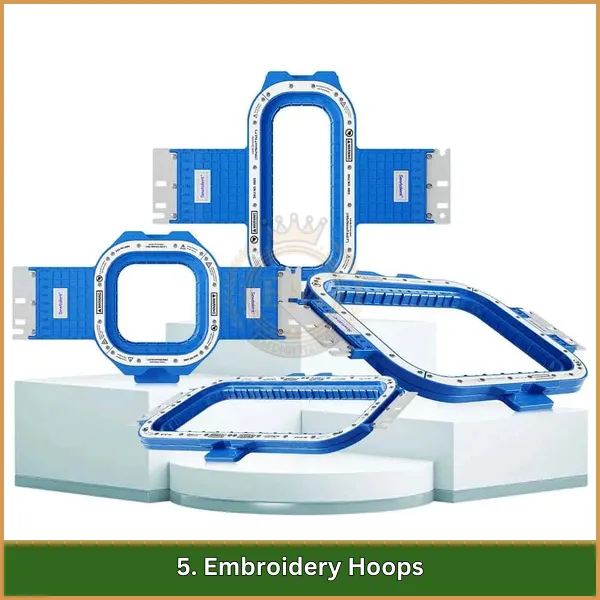
Die Spannreifen halten Ihren Stoff fest und an Ort und Stelle und sorgen für präzises Nähen. Als Anfänger, Beginnen Sie mit einem mittelgroßen Reifen, da es einfacher zu verwalten ist. Reifen gibt es in verschiedenen Größen, Sie können sie in Stickbedarfsgeschäften oder online kaufen. Wenn Ihre Maschine Reifen enthält, Machen Sie sich unbedingt mit der Befestigung und Einstellung vertraut.
6. Stoff (Baumwolle, Leinen, usw.)
Der Stoff, den Sie wählen, bestimmt den Erfolg Ihres Stickprojekts. Für Anfänger, Baumwolle und Leinen lassen sich am einfachsten verarbeiten, da sie robust sind und die Stiche gut halten. Vermeiden Sie empfindliche oder dehnbare Stoffe wie Seide und Jersey, bis Sie mehr Erfahrung haben. Stoff ist in örtlichen Stoffgeschäften oder bei großen Einzelhändlern wie Joann oder Hobby Lobby erhältlich.
7. Schere (Klein, Scharfe)
Eine gute Stickschere ist entscheidend zum Abschneiden von Fäden und zum Ausschneiden kleiner Details. Suchen Sie nach einer scharfen Schere, spitze Spitze, um Präzision zu gewährleisten. Diese sind in Kunsthandwerksgeschäften und online weit verbreitet. Anfänger sollten in ein hochwertiges Paar investieren, um Frustrationen bei Projekten zu vermeiden.
8. Markierungswerkzeuge (Abwaschbare Stifte oder Kreide)
Markierungswerkzeuge werden verwendet, um Designs nachzuzeichnen oder die Platzierung auf Stoff zu markieren. Anfänger sollten sich für abwaschbare Stifte oder Schneiderkreide entscheiden, um bleibende Spuren zu vermeiden. Diese Werkzeuge sind kostengünstig und in Bastelgeschäften oder online erhältlich. Stellen Sie sicher, dass sich die Markierungen nach dem Nähen leicht entfernen lassen, damit Ihr Projekt sauber und professionell bleibt.
9. Vorgefertigte Stickdesigns oder individuelle Designs
Stickmotive machen Ihr Projekt einzigartig. Anfänger können mit vorgefertigten Designs beginnen, die online auf Websites wie EmbroideryDesigns verfügbar sind, Zdigitizing oder UrbanThreads. Diese Designs gibt es in verschiedenen Größen und Formaten, die mit den meisten Maschinen kompatibel sind.
Wenn Sie ein individuelles Design wünschen, Wir können helfen! Bei EMdigitizing, Wir bieten hochwertige kundenspezifische Stickerei-Digitalisierungsdienste zu erschwinglichen Preisen. Ob Sie ein Logo benötigen, Monogramm, oder kompliziertes Design, Wir digitalisieren es perfekt. Unsere Dienstleistungen sorgen für reibungslose Nähergebnisse, und wir garantieren hochwertige, auf Ihre Bedürfnisse zugeschnittene Designs. Besuchen Sie unsere Website, um mehr zu erfahren!
Schritt-für-Schritt-Anleitung für Maschinenstickerei für Anfänger
Schritt 1: Richten Sie Ihre Stickmaschine ein
Beginnen Sie damit, Ihre Stickmaschine richtig einzurichten:
- Befestigen Sie die Stickeinheit sicher, wenn es sich um ein separates Teil handelt.
- Setzen Sie eine geeignete Sticknadel ein (75/11 oder 90/14) und fädeln Sie die Maschine gemäß den mitgelieferten Anweisungen ein.
Schritt 2: Wählen Sie Ihr Design
Wählen Sie ein Design zum Sticken:
- Beginnen Sie mit einem Basic, vorgefertigtes Design, um die Dinge einfach zu halten.
- Stellen Sie sicher, dass das Designdateiformat mit der Kompatibilität Ihrer Maschine übereinstimmt.
Schritt 3: Bereiten Sie Ihren Stoff und Stabilisator vor
Bereiten Sie Stoff und Vlies vor:
- Schneiden Sie ein Stück Stoff zu, das größer als Ihr Rahmen ist, um enge Kanten zu vermeiden.
- Passen Sie Ihren Stabilisatortyp an (wegreißen, weggeschnitten, oder wegwaschen) Passen Sie es an die Bedürfnisse des Stoffes an und legen Sie es zur Unterstützung unter den Stoff.
Schritt 4: Spannen Sie Ihren Stoff richtig ein
Hooping ist der Schlüssel zu einem erfolgreichen Ergebnis:
- Legen Sie den Stabilisator in den äußeren Rahmen.
- Glätten Sie Ihren Stoff darüber, um Falten zu entfernen.
- Fixieren Sie beide Lagen, indem Sie den inneren Rahmen sichern.
Schritt 5: Laden Sie Ihr Design
Bringen Sie Ihr Design in die Maschine:
- Verwenden Sie zum Übertragen der Datei einen USB-Stick oder eine Direktverbindung.
- Navigieren Sie durch die Benutzeroberfläche, um Ihr Design zu finden und auszuwählen.
Schritt 6: Beginnen Sie mit dem Nähen
Es ist Zeit, mit dem Sticken zu beginnen:
- Befestigen Sie den eingespannten Stoff an der Maschine.
- Überprüfen Sie die Einstellungen wie Fadenspannung und Stichart noch einmal.
- Drücken Sie Start und beobachten Sie, wie die Maschine Ihr Design zum Leben erweckt!
Schritt 7: Überwachen und beenden Sie das Design
Behalten Sie den Prozess im Auge:
- Seien Sie bereit, Thread-Unterbrechungen oder -Pausen zu beheben.
- Sobald es abgeschlossen ist, Entfernen Sie den Rahmen vorsichtig und schneiden Sie überschüssiges Vlies und Fäden ab, um ein sauberes Finish zu erzielen.
Schritt 8: Kümmern Sie sich um Ihr fertiges Produkt
Befolgen Sie die richtigen Pflegeschritte:
- Stabilisator bei Bedarf abwaschen.
- Behandeln Sie Ihren bestickten Stoff sorgfältig, um seine Qualität zu erhalten.
Dieser unkomplizierte Prozess wird Ihnen dabei helfen, Ihr erstes Stickprojekt sicher abzuschließen!
Behebung häufiger Probleme beim Maschinensticken
Beginnen mit Maschinenstickerei für Anfänger kann eine unterhaltsame und kreative Reise sein, Aber es ist nicht ungewöhnlich, dass man sich einigen Herausforderungen stellen muss. Hier finden Sie einige häufig auftretende Probleme und praktische Lösungen, die Ihnen bei der Erstellung makelloser Stickprojekte helfen.
1. Thread reißt ständig ab

Eines der frustrierendsten Probleme ist der häufige Fadenbruch, was Ihren Arbeitsablauf stören kann.
So beheben Sie das Problem:
- Überprüfen Sie den Einfädelweg, um sicherzustellen, dass alles richtig eingerichtet ist.
- Verwenden Sie hochwertige Stickgarne, um ein Ausfransen oder Reißen zu vermeiden.
- Stellen Sie die Fadenspannung auf ein ausgewogenes Niveau ein, um ein gleichmäßigeres Nähen zu erzielen.
2. Stofffalten oder Fältchen
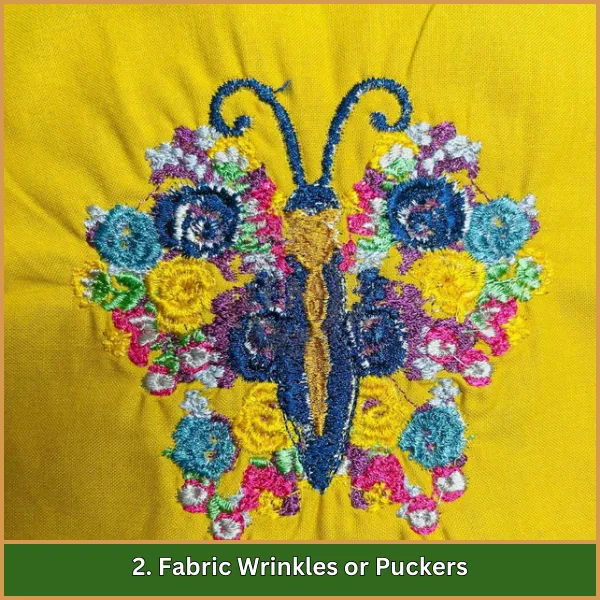
Kräuseln entsteht, wenn sich der Stoff rund um Ihr Design rafft oder knittert, das endgültige Aussehen ruinieren.
So beheben Sie das Problem:
- Wählen Sie ein Vlies, das zur Art und zum Gewicht Ihres Stoffes passt.
- Spannen Sie den Stoff sicher ein, Stellen Sie sicher, dass es straff, aber nicht gedehnt ist.
- Testen Sie Ihr Design an einem ähnlichen Stoffrest, um Überraschungen zu vermeiden.
3. Übersprungene Stiche
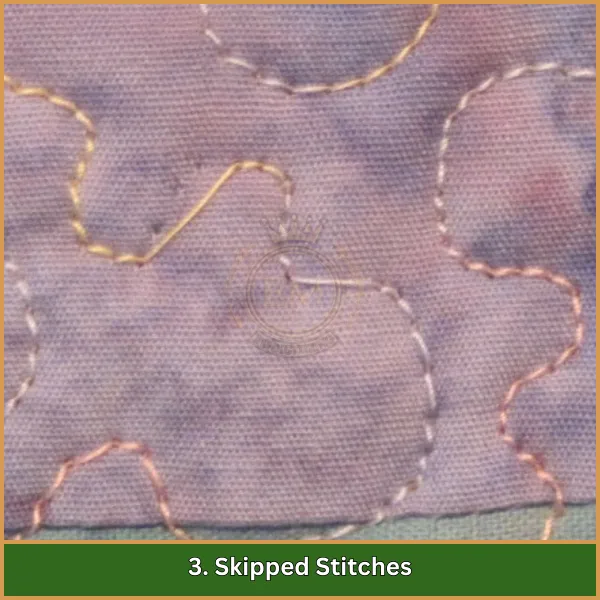
Fehlende Stiche in Ihrem Design können dazu führen, dass es unvollständig und unprofessionell aussieht.
So beheben Sie das Problem:
- Tauschen Sie die Nadel aus, wenn sie stumpf oder verbogen ist; Zum Sticken eignet sich am besten eine scharfe Nadel.
- Passen Sie die Nadelgröße an die Art des Garns und den Stoff an, den Sie verwenden.
- Reduzieren Sie die Maschinengeschwindigkeit für komplizierte oder detaillierte Designs.
4. Darunter ein verwickelter Faden (Vogelnest)
Ein Vogelnest aus Fäden auf der Stoffunterseite kann Ihr Projekt ruinieren und Zeit verschwenden.
So beheben Sie das Problem:
- Reinigen Sie den Spulenbereich, um Flusen und Schmutz zu entfernen.
- Verwenden Sie eine richtig gewickelte Spule und stellen Sie sicher, dass sie richtig eingesetzt ist.
- Gleichen Sie die Ober- und Unterfadenspannung aus, um ein gleichmäßiges Nähen zu gewährleisten.
5. Maschine läuft zu langsam
Eine langsam laufende Maschine kann das Sticken mühsam machen.
So beheben Sie das Problem:
- Überprüfen Sie die Maschineneinstellungen und passen Sie die Geschwindigkeit an Ihr Projekt an.
- Führen Sie regelmäßige Wartungsarbeiten durch, inklusive Reinigen und Ölen, um Ihre Maschine in gutem Zustand zu halten.
6. Der Unterfaden zieht nicht an
Wenn die Maschine den Unterfaden nicht fängt, es wird nicht richtig genäht.
So beheben Sie das Problem:
- Ersetzen Sie eine verbogene oder stumpfe Nadel durch eine neue.
- Fädeln Sie sowohl den Ober- als auch den Unterfaden erneut ein, Befolgen Sie zur Gewährleistung der Genauigkeit das Handbuch der Maschine.
7. Reifenspuren auf Stoff
Reifenspuren können auf empfindlichen Stoffen unerwünschte Abdrücke hinterlassen, Ihre fertige Arbeit beeinträchtigen.
So beheben Sie das Problem:
- Verwenden Sie Magnetrahmen oder vermeiden Sie es, den Stoff zu fest einzuspannen.
- Entfernen Sie Flecken, indem Sie den Stoff nach dem Sticken sanft dämpfen oder waschen.
Fazit
Der Einstieg in die Maschinenstickerei für Anfänger öffnet die Tür zu endlosen kreativen Möglichkeiten. Mit ein wenig Übung und der richtigen Herangehensweise, Sie beherrschen die Kunst, einfache Stoffe in personalisierte Meisterwerke zu verwandeln. Jeder Stich bringt Sie der Perfektionierung Ihrer Fähigkeiten und der Erkundung aufregender neuer Projekte näher.
Um Ihre Stickerei auf die nächste Stufe zu heben, Vertrauen Sie EMDigitizing für alle Ihre Digitalisierungsanforderungen. Wir bieten Premium-Qualität Digitalisierung von Dienstleistungen zu unschlagbaren Preisen, Gewährleistung schneller Durchlaufzeiten und außergewöhnlicher Ergebnisse. Plus, Mit unserer einzigartigen Vorschauoption können Sie Ihr Design sehen, bevor es fertiggestellt ist, So wissen Sie genau, was Sie erwartet.
Wenn Sie neu bei EMDigitizing sind, Wir haben ein besonderes Vergnügen für Sie: Genießen Sie ein exklusives 50% Rabatt auf Ihre erste Bestellung! Lassen Sie uns dabei helfen, Ihre kreativen Ideen in atemberaubende Stickdesigns umzusetzen. Besuchen EMDigitalisierung noch heute und erleben Sie den Unterschied!
Häufig gestellte Fragen
Beginnen Sie damit, eine einsteigerfreundliche Maschine auszuwählen und Materialien wie Fäden zusammenzustellen, Nadeln, und Stabilisatoren. Nutzen Sie Online-Tutorials und Einsteiger-Kits, um in Ihrem eigenen Tempo zu üben. Treten Sie Stick-Communitys bei, um Tipps zu erhalten, Unterstützung, und Feedback.
Eine Einnadelmaschine mit einfacher Steuerung und integriertem Design, wie Brother PE535 oder Janome 400E, ist ideal. Suchen Sie nach Modellen mit klaren Anweisungen und Supportressourcen. Diese Maschinen machen das Lernen einfach und angenehm.
Machen Sie sich mit Ihrer Stickmaschine vertraut, indem Sie das Handbuch lesen und das Einfädeln üben. Beginnen Sie mit einfachen Mustern auf Stoffresten, um Selbstvertrauen aufzubauen. Gehen Sie nach und nach zu komplexen Designs über, während sich Ihre Fähigkeiten verbessern.
Maschine aufstellen und einfädeln, Wählen Sie dann Ihr Design aus und laden Sie es. Spannen und stabilisieren Sie Ihren Stoff sicher, bevor Sie mit dem Sticken beginnen. Zum Schluss die Fäden abschneiden und überschüssiges Vlies entfernen.
